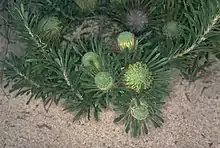Banksia tridentata
Banksia tridentata, commonly known as yellow honeypot,[2] is a low-growing shrub that is endemic to the southwest of Western Australia. It has narrow egg-shaped leaves with a sharp point on the tip, greenish yellow flowers in heads of between 85 and 125, and elliptical to egg-shaped follicles.
| Yellow honeypot | |
|---|---|
 | |
| Banksia tridentata near Cervantes | |
| Scientific classification | |
| Kingdom: | Plantae |
| Clade: | Tracheophytes |
| Clade: | Angiosperms |
| Clade: | Eudicots |
| Order: | Proteales |
| Family: | Proteaceae |
| Genus: | Banksia |
| Subgenus: | Banksia subg. Banksia |
| Series: | Banksia ser. Dryandra |
| Species: | B. tridentata |
| Binomial name | |
| Banksia tridentata | |
| Synonyms[1] | |
Description
Banksia tridentata is a shrub that typically grows to a height of 15–50 cm (5.9–19.7 in) and forms a lignotuber. It has narrow egg-shaped leaves 15–45 mm (0.59–1.77 in) long and 2.5–5 mm (0.098–0.197 in) wide on a petiole 1–3 mm (0.039–0.118 in) long. There is a small sharp point on the tip and sometimes two or three small teeth near the tip of the leaf. The flowers are greenish yellow and arranged in heads of between 85 and 125 with hairy, linear, tapering involucral bracts up to 15 mm (0.59 in) long at the base of the head. The perianth is 25–28 mm (0.98–1.10 in) long and the pistil 30–40 mm (1.2–1.6 in) long. Flowering occurs from August to September and the fruit is a sparsely hairy, elliptical to egg-shaped follicle 11–15 mm (0.43–0.59 in) long.[2][3]
Taxonomy
This species was first formally described in 1856 by Carl Meissner who gave it the name Dryandra tridentata and published the description in Hooker's Journal of Botany and Kew Garden Miscellany.[4][5]
In 1893 Benjamin Daydon Jackson accidentally listed it in Index Kewensis under Banksia, thus unwittingly publishing the name Banksia tridentata. This is now the current name for the species, as in 2007 all Dryandra species were transferred to Banksia by Austin Mast and Kevin Thiele.[6][7]
Distribution and habitat
Banksia tridentata grows in kwongan between the Arrowsmith and Hill Rivers.[2][3]
Ecology
An assessment of the potential impact of climate change on this species found that its range is unlikely to contract and may actually grow, depending on how effectively it migrates into newly habitable areas.[8]
Conservation status
This banksia is classified as "not threatened" by the Western Australian Government Department of Parks and Wildlife.[2]
References
- "Banksia tridentata". Australian Plant Census. Retrieved 9 June 2020.
- "Banksia tridentata". FloraBase. Western Australian Government Department of Parks and Wildlife.
- George, Alex S. (1999). Flora of Australia (PDF). 17B. Canberra: Australian Biological Resources Study, Canberra. p. 289. Retrieved 9 June 2020.
- "Dryandra tridentata". APNI. Retrieved 9 June 2020.
- Meissner, Carl; Hooker, William J. (1855). "New Proteaceae of Australia". Hooker's Journal of Botany and Kew Garden Miscellany. 7: 121–122. Retrieved 9 June 2020.
- Mast, Austin R.; Thiele, Kevin (2007). "The transfer of Dryandra R.Br. to Banksia L.f. (Proteaceae)". Australian Systematic Botany. 20 (1): 63–71. doi:10.1071/SB06016.
- "Banksia tridentata". APNI. Retrieved 9 June 2020.
- Fitzpatrick, Matthew C.; Gove, Aaron D.; Sanders, Nathan J.; Dunn, Robert R. (2008). "Climate change, plant migration, and range collapse in a global biodiversity hotspot: the Banksia (Proteaceae) of Western Australia". Global Change Biology. 14 (6): 1–16. doi:10.1111/j.1365-2486.2008.01559.x.
- Cavanagh, Tony; Pieroni, Margaret (2006). The Dryandras. Melbourne: Australian Plants Society (SGAP Victoria); Perth: Wildflower Society of Western Australia. ISBN 1-876473-54-1.